May 20, 1982
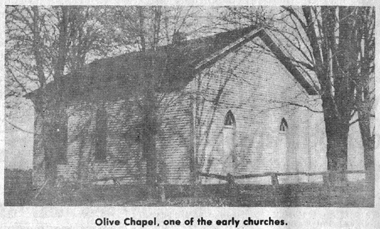
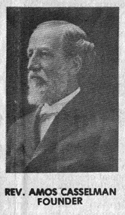
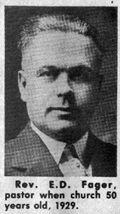
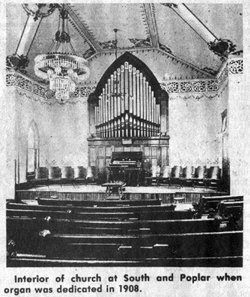
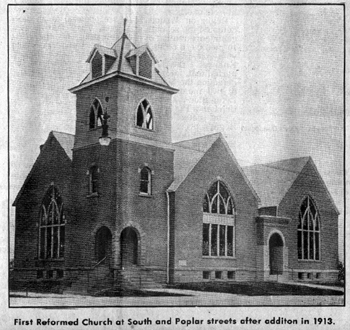
Picture #1 – Olive Chapel, one of the early churches.
Picture #2 – Rev. Amos Casselman – Founder
Picture #3 – Rev. E.D. Fager, pastor when church was 50 years old, in 1929
Picture #4 – Interior of church at South and Poplar when organ was dedicated in 1908.
Picture #5 – First Reformed Church at South and Poplar streets after addition in 1913
EDITOR’S NOTE: This is another of the articles presented from time to time to about the churches in Fostoria. Because of the length of the text and the many photos, it will consist of two installments, this being the first.
Many of the churches in America date back to origins in Europe and the Grace United Church of Christ is no exception.
In the early days of Ohio, many settlers in Seneca County and the surrounding area were of German origin. When they built their churches here they clung to their family religious preferences, but sometimes altering their beliefs to meet the freedom of American and eliminating old church practices which they disliked.
EARLY RURAL CHURCHES
According to Rev. E.D. Fager’s historical notes which he put together in 1929, “In about the year, 1849, there was organized a German reformed church, known as Zion Reformed, located about three miles southwest of Fostoria. As to the exact meeting place of the congregation for the first 15 years, we have no knowledge. However, we have a bill of sale dated Oct. 13, 1864, which shows that John Shilling and his wife Anna, sold a lot to Jacob Earnest and Abraham Deible, trustees of the church for the sum of $10”.
Other than the location of the lot being in Hancock County, section 11, range 12, nothing is known about the church building or the ministers for those early years.
In the early 1850’s, under the leadership of Rector rubin Good, a professor at Heidelberg College, Tiffin, a church was organized near the Rehoboth Church in Jackson Township, Seneca County, on the Conrad Myers farm. The new congregation worshipped for several years in a school building no longer used. Conrad Myers, the first elder of the congregation donated the land. Under the pastorates of Revs. Good, Shaw, Bear, Stauffer, Herrig, Rettig and Richter, the congregation grew to more than 100.
In about 1867, the church in Jackson Township was relocated, and a new building was constructed on a lot purchased from Jacob and eva Stahl, in section 21 in township three, range 13. The church became known as Olive Chapel.
In 1870, The Rev. Theodore Bacher began preaching to a small group of people in Fostoria. He and his congregation purchased a lot to build a church, but when Bacher received a call to the Reformed church in Fremont, the church disbanded.
REV. CASSELMAN WAS ORGANIZER
Then in 1875, Rev. Amos casselman, a student in the Heidelberg Theological Seminary, Tiffin, began serving Olive Chapel as a supply-minister, preaching every other Sunday to a congregation of approximately 40.
Sometime later, Casselman learned of the Zion Church, mentioned earlier, which had been abandoned. Only a few of the former members were still living in the vicinity of the church, but the old church records were available. The church was cleaned and repaired, and Casselman started preaching there too. Soon, approximately 75 members were attending.
Zion and Olive Chapel later joined in issuing a call to Casselman to serve the two congregations, which he did until 1883. The initial salary was $300 per year, without parsonage. Later, the salary was increased to $550 per year, plus house rent.
At the same time, Casselman served Zion and Olive Chapel, he also filled in at the Congregational Church in West Millgrove, and occasionally preached in one of the Fostoria churches to add to the meager salary.
During that period of time when Rev. Casselman was serving Zion and Olive Chapel, he had one main objective – to form a church in Fostoria, but he had to wait until conditions were right.
The old Zion church, badly in need of repair at that time, was abandoned by vote of the congregation. The United Brethren Church in Fostoria was secured for holding Sunday afternoon services, which began Dec. 1, 1878.
FOSTORIA CHURCH ORGANIZED IN 1879
One man, Henry W. Konkle, a brick layer and contractor had offered to pay $120 for a building fund to start a church in Fostoria. That was the start which eventually made Casselman’s dream come true. He called the congregational church in March 1879, at which time the church was formally organized.
The following became charter members: Henry W. Konkle, Rev. and Mrs. Martin Mueller, Jacob Hoffmaster, Catherine Hoffmaster, Lydia Hoffmaster, Hannah Hoffmaster, Samuel Stewart, Mrs. Samuel Stewart, Kate Stewart, Mrs. Catherine Felkley, Ann Felkley, Mrs. Jacob Schaufelberger, Mary Schaufelberger, Amelia Schauffelberger, Mrs. John Andes, Mrs. John Wagner, Michael Moots, Mrs. Mary Hooper, Daniel Ecker, Mrs. Daniel Ecker, Mrs. Sarah Milhime. Other joining later were: Jacob Schauffelberger, George Earnest, Peter Ecker, John Wagner, Mrs. Elias Fox, Mrs. Serepta Colman and John Colman.
The name Grace Reformed Church of Fostoria was adopted. The charter was received from the state April 20, 1879. Martin Mueller and Henry W. Konkle were elected elders and Samuel Stewart and Jacob Hoffmaster as deacons.
FIRST CHURCH ON WEST NORTH
The list of contributions for a new church building soon reached $1,200. A lot (No. 176) on West North Street was purchased from James and Laura Fritcher for $300 and building plans were completed. That lot where the church was built is now the site of a two-family apartment house, numbers 252-254 on the north side of West North, next to PK Lumber Co.
When the building was completed, it was described as “an attractive frame building with a vestibule and a gallery”. A good bell was hung in the spire and a good reed organ was purchased. The pulpit and pews were homemade. It was not as large as some of the other churches in Fostoria but as comfortable and cozy as any, with a seating capacity of about 250. The total cost was $2,500.
Dedication of the new church was Sept 28, 1879, with Rev. J.H. Good, DD, and Rev. Theodore J. Bacher of Wooster, the preachers for that day. Thereafter, services were held every Sunday morning and evening and mid-week, with Rev. Casselman continuing as pastor. He also conducted services at Olive Chapel on Sunday afternoons.
So, readers can see how slowly, but surely, the efforts of many pastors and the desires of individuals to have church buildings for worship of God were finally brought to fruition with the establishment of Grace Reformed Church.
NEXT CHURCH AT POPLAR AND SOUTH
The Grace Reformed Church continued in their church on West North Street for about 20 years. On Aug. 28, 1898, the consistory decided to look for a new location. Two lots were secured at Poplar and South streets by trading the church-owned parsonage at 432 W. Fremont St., and paying an additional $200.
The church lots on West North Street were traded to Koss & German Lumber Co. for $600 worth of material for the new church building. When the old church building was later torn down, the material was used to erect the parsonage for the new church.
The contract for the new church was awarded to F.P. Lindsey at $3,572. Work was started Sept. 29, 1900, and it was ready for use and dedication Jan. 20, 1901.
The next few years saw other improvements and additions to the new church and the name was changed to the First Reformed Church in 1901. In January 1908, permission was given to the young people’s Christian Endeavor to raise funds for a new organ. they succeeded with the help of Andrew Carnegie who donated one half of the cost of $1,400. Installation and other changes to accomodate the organ raised the cost to $2,000.
In 1913, the consistory appointed a committee consisting of J.A. Peter, J.F. Fruth, Fred Flechtner, Allen Keefe, F.A. Harmer to plan for the building of an addition to the church to serve as a Sunday school room. The new addition was completed at a cost of $7,000. Dedication took place Nov. 29, 1914. Dr. Charles E. Miller, Rev. O.G. King and Rev. G.W. Good participated in the dedication services.
In 1924, various improvements, repairs and redecorating of the church was completed including new lighting fixtures at a total cost of $7,000. At that time, Mrs. Josephine Keefe and son Curtis gave the church a new marble baptism font in memory of Orris Allen and Lulu Keefe, children of Josephine.
50TH BIRTHDAY IN 1929
In 1929, when Rev. E.D. Fager was still pastor and the Grace Reformed Church was 50 years old, he challenged the congregation during their golden anniversary “to bring 50 living candles for the church’s birthday, candles in whole hearts is the Light of Eternity. Those 50 new candles could give us a membership of 364, he said.
The anniversary services were held from March 18-22, 1929, a full week of meetings with speakers for the various groups in the church, men, women and young people.